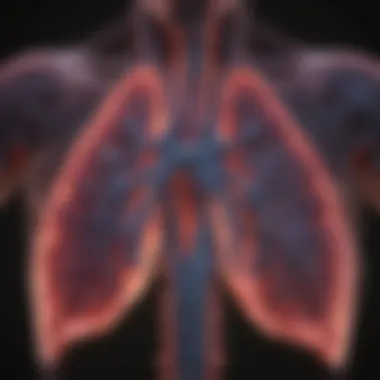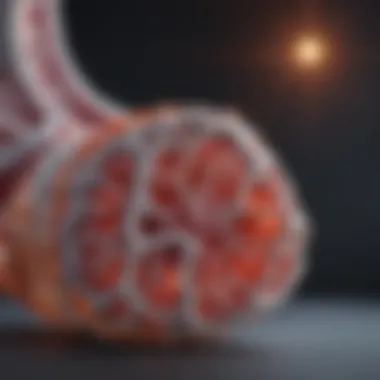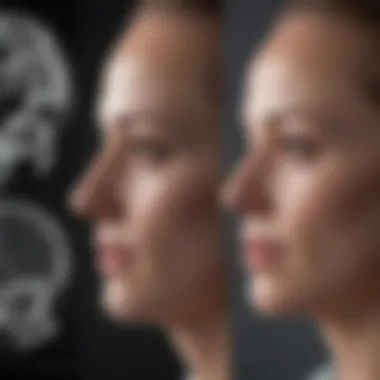The Importance of PET Scans in Small Cell Lung Cancer


Intro
Positron Emission Tomography, commonly known as PET scans, has become a cornerstone in modern oncology, especially for diagnosing small cell lung cancer (SCLC). As a unique and aggressive type of lung cancer, SCLC's characteristics demand precise imaging methods for appropriate diagnosis and treatment. This section will set the stage by exploring the essential role of PET scans in identifying and management of SCLC.
Foreword to Small Cell Lung Cancer
Small cell lung cancer (SCLC) is a complicated disease that poses serious challenges for both diagnosis and treatment. Understanding its unique characteristics is crucial, as SCLC tends to be aggressive and is often diagnosed at an advanced stage. This article sheds light on various aspects of SCLC, particularly focusing on how PET scans play a pivotal role in its management.
The significance of this foundation cannot be overstated. In the realm of oncology, timely and accurate diagnosis is crucial. SCLC, specifically, is known for its rapid growth and propensity to spread to other parts of the body. Thus, understanding what it is, its epidemiology, and its risk factors can guide healthcare professionals in making informed decisions that can improve patient outcomes.
Key elements are explored in-depth in this section, providing a holistic view of SCLC:
- Definition and Overview: This part delves into what small cell lung cancer is, its biological behavior, and how it differs from other types of lung cancer.
- Epidemiology and Risk Factors: Identifying who is at risk and understanding the patterns of its incidence can aid in preventive strategies and early detection methods.
Understanding these components not only aids researchers and clinicians in their work but also helps educate and empower patients and their families about this challenging diagnosis. A well-informed patient can engage more effectively with their healthcare team, making discussions around treatment options and care plans more productive.
"Education is the most powerful weapon which you can use to change the world." - Nelson Mandela
In sum, delving into small cell lung cancer lays the groundwork for a comprehensive discussion on how modern imaging techniques like PET scans contribute to the diagnosis and treatment of this challenging cancer type.
Understanding PET Scans
Positron Emission Tomography (PET) scans have become a critical component in diagnosing and managing small cell lung cancer (SCLC). Their ability to provide detailed images of the metabolic activity of cancer cells makes them invaluable for clinicians. Unlike traditional imaging techniques, PET scans not only depict anatomical structures but also highlight the biochemical processes occurring within tumors. This dual capability enhances the overall understanding of the disease's stage and behavior, which in turn plays a pivotal role in treatment planning.
Understanding PET scans involves appreciating their principles, the technology behind them, and their specific contributions to the diagnostics of SCLC. Given the aggressive nature of small cell lung cancer, timely and accurate diagnosis is paramount. The insights gained from PET imaging can lead to quicker decisions regarding treatment options, such as chemotherapy or radiation therapy, ultimately improving a patient's prognosis.
Principles of Positron Emission Tomography
PET scans operate on the principle of detecting gamma rays emitted by radiotracers in the body. When a radiotracer is injected into the patient, it emits positrons, which are the antimatter counterparts of electrons. When these positrons collide with electrons, they annihilate each other, releasing gamma photons. The PET scanner detects these photons and reconstructs them into detailed images.
This imaging technique offers a significant advantage because it can reveal changes at the molecular level often before they manifest visibly on traditional imaging methods. For individuals with SCLC, this means physicians can catch the disease earlier, assess the extent of any spread, and gauge how well the cancer is responding to treatment.
Moreover, PET scans can be performed alongside computed tomography (CT) in what is called PET/CT imaging. This combination gives a more comprehensive view—while the CT scan shows the anatomy, the PET scan highlights the metabolic activity. This layering of information is crucial for developing an effective treatment plan.
Radiotracers and Their Role in Imaging
Radiotracers are the linchpins in PET imaging. These substances are tagged with radioactive isotopes and are crucial for visualizing cancerous tissues. The most commonly used radiotracer for cancer imaging is fluorodeoxyglucose (FDG). This compound mimics glucose, allowing it to be absorbed preferentially by active cancer cells, which tend to have higher metabolic rates than normal cells.
The significance of radiotracers in SCLC diagnosis cannot be overstated:
- Specificity: They help distinguish between cancerous and non-cancerous tissues based on metabolic activity.
- Sensitivity: PET scans can detect even tiny lesions that might be missed by other imaging modalities.
- Monitoring: They play a role in assessing treatment effectiveness by showing how quickly or slowly a tumor is responding to therapy.
Each type of radiotracer has its own specific applications. While FDG is widely used, other radiotracers are in development or under research, aimed at providing more precise imaging or targeting other biological markers associated with small cell lung cancer.


"The insights from PET scans guide clinicians in making informed decisions about the management of small cell lung cancer, a disease that often presents significant challenges due to its aggressive nature."
In summary, understanding PET scans is not just about the imaging process; it is about the real-world impact of this technology on patient diagnosis and management throughout their cancer journey.
The Diagnostic Process for SCLC
Diagnosing small cell lung cancer (SCLC) is a complex endeavor that requires a multifaceted approach. The process involves a combination of clinical evaluations, laboratory testing, and various imaging techniques to formulate a comprehensive picture of the patient’s health. The importance of this diagnostic process cannot be overstated, as accurate and timely diagnosis significantly influences treatment choices and management strategies. As healthcare professionals, understanding this process enables better communication with patients about what to expect, ultimately leading to better patient outcomes.
Initial Evaluation and Testing
The initial evaluation for SCLC typically includes a detailed medical history and physical examination. Physicians will look for symptoms such as persistent cough, unexplained weight loss, and recurrent respiratory infections, which may indicate SCLC. Although these symptoms can point toward various lung conditions, SCLC might be suspected if the patient has a significant smoking history or other risk factors.
Laboratory tests, including complete blood counts and chemistry panels, are often employed to give insights into the patient’s overall health. However, these tests alone do not diagnose SCLC. Instead, they help gauge how well the patient's body is functioning and can indicate other issues that may require attention before progressing to definitive imaging and biopsies.
Imaging Modalities in SCLC
A robust diagnostic process for SCLC also necessitates the use of effective imaging modalities. Here, we will discuss three main techniques: CT scans, MRI, and PET scans, outlining their roles, uniqueness, and implications.
CT Scans
CT scans, or computed tomography scans, are often the first imaging test performed when lung cancer is suspected. They allow for detailed cross-sectional images of the lungs, identifying masses and potential metastases. One of the key characteristics of CT scans is their high resolution, which gives healthcare professionals a clearer picture of the tumor's size and location.
What makes CT scans especially popular in diagnosing SCLC is their ability to quickly evaluate the thoracic cavity. This quick assessment is critical as SCLC can spread aggressively. However, while CT scans can detect structural abnormalities, they cannot provide metabolic information. Thus, while they are beneficial for initial diagnosis, they often need to be used in conjunction with other imaging tests for a more complete assessment.
MRI
Magnetic Resonance Imaging (MRI) is another valuable tool in the diagnostic arsenal. It is particularly useful for evaluating soft tissue structures and can provide detailed images of the brain and spinal cord, areas where SCLC may metastasize. One of the distinguishing features of MRI is its lack of ionizing radiation, making it a safer option for patients who may need multiple scans.
However, MRI’s prominence is generally more pronounced in cases where neurological involvement is suspected or confirmed. Although MRI offers superior soft tissue contrast, certain limitations, such as its time-consuming nature and higher cost compared to CT, can affect its use in routine SCLC assessments.
PET Scans
PET scans, or Positron Emission Tomography scans, have made significant strides in the realm of cancer diagnostics, including SCLC. They are pivotal in providing metabolic and functional information about cancerous tissues. A unique feature of PET scans is their ability to track the body's metabolic activity, highlighting areas of increased glucose metabolism typical of cancerous cells.
This characteristic is what makes PET scans stand out. They are not only beneficial for staging SCLC but also for assessing treatment responses. While they offer a wealth of information, it is essential to note that PET scans may be influenced by several factors—such as recent infections or inflammation—that could lead to false positives. Despite this, their integration into the diagnostic process enhances the overall accuracy of cancer evaluation and subsequent management.
"The strength of a PET scan lies not just in its ability to visualize tumors but in its capacity to offer insights into their metabolic activity, which often dictates treatment choices."
The Specific Role of PET Scans in SCLC
The significance of PET scans in the context of small cell lung cancer (SCLC) cannot be overstated. As a specialized imaging technique, PET provides oncologists with vital information regarding the state of the cancer, which in turn influences treatment decisions and patient outcomes. In SCLC, a disease notoriously known for its aggressiveness and rapid progression, timely and accurate staging is crucial. This section explores how PET scans play a pivotal role in staging cancer, assessing treatment responses, and ultimately predicting prognosis.
Staging of Small Cell Lung Cancer


Staging is a fundamental aspect of cancer management, providing a framework to understand the extent of the disease. With SCLC, which is often diagnosed at an advanced stage, precise staging is critical. PET scans are valuable because they enable oncologists to visualize metabolic activity in tissues, allowing for the detection of cancerous cells that may not be visible through other imaging modalities, like CT scans.
- Comprehensive Evaluation: PET scans can help clinicians identify both primary tumors and potential metastases, offering a panoramic view of the cancer's spread throughout the body. This integration of metabolic and anatomical data enhances the accuracy of staging.
- Clinical Trials: Many clinical trials leverage PET imaging to determine eligibility and assess treatment responses, underscoring its role in modern oncology.
"A well-staged cancer leads to better treatment planning, and PET scans have become a cornerstone in that process, particularly in SCLC."
Assessing Treatment Response
Monitoring how SCLC responds to treatment is essential for optimizing therapy. PET scans, due to their capability to measure metabolic changes, offer oncologists a valuable tool for evaluating treatment efficacy.
- Early Detection: PET scans can sometimes reveal treatment effects earlier than traditional imaging methods. This early information allows healthcare providers to adapt treatment plans promptly if the cancer does not respond as expected.
- Quantifiable Metrics: By measuring the standardized uptake values (SUV) in tumors, doctors can objectively assess how much glucose the cancer cells are consuming, providing insight into whether the tumor is shrinking or remaining stable during therapy.
Predicting Prognosis
The ability to predict outcomes in SCLC patients is a significant advantage of utilizing PET scans. Prognosis can vary widely among individuals, and understanding how far cancer has spread can help caregivers make informed decisions.
- Biomarkers: Research has shown that higher levels of glucose metabolism indicated by PET scans may correlate with poorer outcomes. Thus, the metabolic profile garnered from PET imaging can serve as a biomarker for prognosis.
- Risk Stratification: Clinicians use PET scan results to stratify patients into different risk categories, guiding discussions regarding treatment goals and palliative care needs.
In summary, PET scans serve as an indispensable asset in the diagnostic toolkit for small cell lung cancer, closely guiding clinicians through staging, assessing treatment response, and predicting outcomes. This integration of advanced imaging into routine care represents a step forward in managing such a challenging malignancy.
Limitations of PET Scans in SCLC
Understanding the limitations of PET scans in diagnosing small cell lung cancer (SCLC) is crucial for medical professionals and patients alike. While these scans have made a significant impact on cancer detection and treatment, they are not without their drawbacks. Knowing these limitations helps in developing a comprehensive view of a patient’s condition and in selecting the best imaging methods to complement PET scans.
Challenges in Interpretation
One of the key challenges with PET scans is the interpretation of the results, which is not always straightforward. The images produced can be ambiguous, leading to different conclusions based on the same data. For instance, areas of increased glucose uptake may not solely indicate malignant growth; they can also reflect inflammation or infection. This can particularly affect the detection of SCLC, which often coexists with various other conditions in the lungs.
Moreover, the interpretation can vary significantly among radiologists, where experience and individual expertise play a major role. A seasoned radiologist might recognize subtle cues that a less experienced one could overlook. Hence, having a multidisciplinary team discussing the findings is often beneficial. In addition, the timing of the scan can also impair clarity; for example, if conducted too soon after therapy, residual active metabolism might be misinterpreted as tumor recurrence. Thus, these challenges highlight the need for careful diagnostic strategy and expertise.
False Positives and Negatives
Another major concern with PET scans lies in the occurrence of false positives and negatives. These can lead to diagnostic confusion and inappropriate treatment choices.
- False positives can arise when non-cancerous tissues display heightened metabolic activity. Conditions such as pneumonia, granulomatous disease, or even post-surgical changes can absorb the radiotracer used in PET scans, mimicking SCLC.
- False negatives, on the other hand, present a different set of challenges. In cases where the tumor is small or has low metabolic activity, the PET scan may fail to detect it altogether. This is significant for small cell lung cancer, as early and accurate detection is key to improving prognosis.
Both false positives and negatives necessitate follow-up testing, often with more precise imaging techniques like CT or MRI, which can lead to increased time and costs. This underscores a vital caution: while PET scans are a powerful tool, they should not be viewed in isolation. They ought to be part of a larger framework that combines multiple imaging modalities and clinical evaluation.
In summary, while the PET scan remains an invaluable asset in the oncological toolkit, understanding its limitations—interpretation challenges and the risk of false positives and negatives—ensures that healthcare providers can make informed and balanced decisions in managing SCLC. It's a fine line between the usefulness of advanced imaging technology and the need for comprehensive diagnostic precision.
Emerging Techniques in Imaging for SCLC
The field of medical imaging is continually evolving, particularly in its application for diagnosing small cell lung cancer (SCLC). Emerging techniques not only aim to improve accuracy but also enhance the overall management of the disease. These advancements often directly impact how clinicians interpret PET scans and combine them with other diagnostic tools, leading to timely and more effective treatment plans.


Advancements in Radiotracer Developments
Radiotracers are essential to the function of PET scans, with ongoing research entering new frontiers. One significant advancement is the development of new radiotracers that offer improved specificity for cancerous tissues. For example, the use of gallium-68 DOTATATE helps in identifying neuroendocrine tumors more successfully than conventional methods.
The benefits of these advancements cannot be overstated. With enhanced localization of tumors and lower background noise, clinicians can visualize small lesions that might otherwise be missed. Layout of imaging with selective radiotracers enables tailored therapy decisions based on the biological behavior of the tumor itself, which is particularly crucial when dealing with the aggressive nature of SCLC.
Integration of PET with Other Modalities
Hybrid Imaging Techniques
Hybrid imaging techniques, such as PET/CT or PET/MRI, represent a significant leap in diagnostic capabilities. By marrying the metabolic information from PET scans with the structural data from CT or MR imaging, these techniques allow for a more comprehensive understanding of the tumor's characteristics and its surrounding anatomy.
One key characteristic of hybrid imaging is its ability to reduce the time needed for diagnosis. With both functional and anatomical insights provided in a single examination, physicians can make informed decisions without subjecting patients to multiple imaging sessions. Moreover, these integrated modalities can help differentiate between benign and malignant lesions more effectively, reducing the chances of unnecessary invasive procedures.
However, hybrid imaging also carries disadvantages. The increased complexity can lead to higher costs and requires specialized training for proper interpretation. There is also a risk that the sheer volume of data could overwhelm practitioners, potentially obscuring important findings.
Artificial Intelligence in Imaging
The incorporation of artificial intelligence (AI) in imaging for small cell lung cancer diagnosis is a game changer. AI algorithms can analyze imaging data, pinpointing patterns that might escape a human eye. What stands out about AI in this context is its ability to learn from vast datasets, improving diagnostic precision over time.
AI serves as a beneficial tool for radiologists, allowing them to focus on more complex cases while automating routine interpretations. For instance, using machine learning models can make real-time assessments during scans, generating insights that assist in immediate decision-making and speeding up the diagnostic workflow.
Nevertheless, while AI holds promise, it doesn’t come without concerns. Dependency on AI might lead to less hands-on experience for radiologists and raises questions about accountability in diagnostics. Additionally, the ethical implications of AI use in medicine still warrant careful consideration.
These advances represent a significant stride toward the future of oncology, opening new avenues for therapies tailored to individual patients.
Finale
In summarizing the significant insights gathered from the exploration of PET scans within the context of small cell lung cancer (SCLC), it is crucial to appreciate their multifaceted role. Rather than just a diagnostic tool, PET scans serve as an essential component in the continuum of care for patients dealing with this aggressive form of lung cancer. Their ability to provide metabolic information, coupled with anatomical imaging, offers a comprehensive view that is invaluable for clinicians.
Summary of Key Findings
The research and discussions throughout this article underscore several key findings:
- Enhanced Staging: PET scans improve the accuracy of staging SCLC, which is vital for devising the most effective treatment plans. They enable differentiation between various stages, allowing more tailored therapeutic approaches.
- Treatment Monitoring: Regular PET imaging helps to assess the efficacy of treatment, providing real-time feedback on how well the therapy is working. This can prompt timely adjustments to treatment protocols if necessary, which can ultimately affect prognosis favorably.
- Limitations: Despite their benefits, the interpretation of PET scans is not free from challenges. Issues such as false positives or negatives can arise, highlighting the need for careful evaluation alongside other diagnostic methods.
Future Directions in Research
Looking ahead, several areas warrant further investigation:
- Improved Radiotracers: Ongoing research into new radiotracers could enhance the specificity and sensitivity of PET scans, potentially reducing the rates of misdiagnosis. Efforts to understand the biological markers linked to SCLC might lead to the creation of more targeted imaging agents.
- AI Integration: The integration of artificial intelligence in interpreting PET scans presents an exciting frontier. Enhanced algorithms could assist radiologists in analyzing complex images more accurately, thereby improving diagnostic outcomes.
- Comparative Studies: More studies comparing the effectiveness of PET scans with other imaging modalities, like advanced MRI techniques, would provide a clearer picture of the current landscape and help refine approaches for SCLC diagnosis and treatment.
Citing Key Studies and Articles
When discussing PET scans in relation to small cell lung cancer, it's essential to ground our arguments in established research. Here’s a enriched list of notable studies and articles:
- The role of PET scans in lung cancer staging: A comprehensive review published in the Journal of Nuclear Medicine that outlines the efficacy of PET scans in various stages of lung cancer.
- Clinical outcomes with PET imaging: A longitudinal study that correlates treatment outcomes with initial PET scan results, found in Cancer Research.
- Emerging PET technologies: Articles from Nature Reviews Cancer discussing innovations that enhance the accuracy of PET imaging.
This collection not only underscores the relevance of PET scans but also provides a blueprint for ongoing clinical practice in the realm of small cell lung cancer diagnosis.
Each citation enriches our understanding and reinforces the message that meticulous research and careful referencing are pivotal in the medical field.















